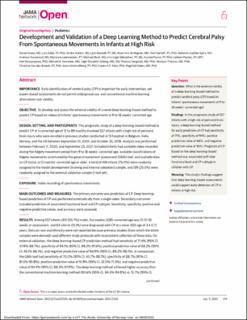| dc.description.abstract | Importance Early identification of cerebral palsy (CP) is important for early intervention, yet expert-based assessments do not permit widespread use, and conventional machine learning alternatives lack validity.
Objective To develop and assess the external validity of a novel deep learning–based method to predict CP based on videos of infants’ spontaneous movements at 9 to 18 weeks’ corrected age.
Design, Setting, and Participants This prognostic study of a deep learning–based method to predict CP at a corrected age of 12 to 89 months involved 557 infants with a high risk of perinatal brain injury who were enrolled in previous studies conducted at 13 hospitals in Belgium, India, Norway, and the US between September 10, 2001, and October 25, 2018. Analysis was performed between February 11, 2020, and September 23, 2021. Included infants had available video recorded during the fidgety movement period from 9 to 18 weeks’ corrected age, available classifications of fidgety movements ascertained by the general movement assessment (GMA) tool, and available data on CP status at 12 months’ corrected age or older. A total of 418 infants (75.0%) were randomly assigned to the model development (training and internal validation) sample, and 139 (25.0%) were randomly assigned to the external validation sample (1 test set).
Exposure Video recording of spontaneous movements.
Main Outcomes and Measures The primary outcome was prediction of CP. Deep learning–based prediction of CP was performed automatically from a single video. Secondary outcomes included prediction of associated functional level and CP subtype. Sensitivity, specificity, positive and negative predictive values, and accuracy were assessed.
Results Among 557 infants (310 [55.7%] male), the median (IQR) corrected age was 12 (11-13) weeks at assessment, and 84 infants (15.1%) were diagnosed with CP at a mean (SD) age of 3.4 (1.7) years. Data on race and ethnicity were not reported because previous studies (from which the infant samples were derived) used different study protocols with inconsistent collection of these data. On external validation, the deep learning–based CP prediction method had sensitivity of 71.4% (95% CI, 47.8%-88.7%), specificity of 94.1% (95% CI, 88.2%-97.6%), positive predictive value of 68.2% (95% CI, 45.1%-86.1%), and negative predictive value of 94.9% (95% CI, 89.2%-98.1%). In comparison, the GMA tool had sensitivity of 70.0% (95% CI, 45.7%-88.1%), specificity of 88.7% (95% CI, 81.5%-93.8%), positive predictive value of 51.9% (95% CI, 32.0%-71.3%), and negative predictive value of 94.4% (95% CI, 88.3%-97.9%). The deep learning method achieved higher accuracy than the conventional machine learning method (90.6% [95% CI, 84.5%-94.9%] vs 72.7% [95% CI, 64.5%-79.9%]; P < .001), but no significant improvement in accuracy was observed compared with the GMA tool (85.9%; 95% CI, 78.9%-91.3%; P = .11). The deep learning prediction model had higher sensitivity among infants with nonambulatory CP (100%; 95% CI, 63.1%-100%) vs ambulatory CP (58.3%; 95% CI, 27.7%-84.8%; P = .02) and spastic bilateral CP (92.3%; 95% CI, 64.0%-99.8%) vs spastic unilateral CP (42.9%; 95% CI, 9.9%-81.6%; P < .001).
Conclusions and Relevance In this prognostic study, a deep learning–based method for predicting CP at 9 to 18 weeks’ corrected age had predictive accuracy on external validation, which suggests possible avenues for using deep learning–based software to provide objective early detection of CP in clinical settings. | en_US |

